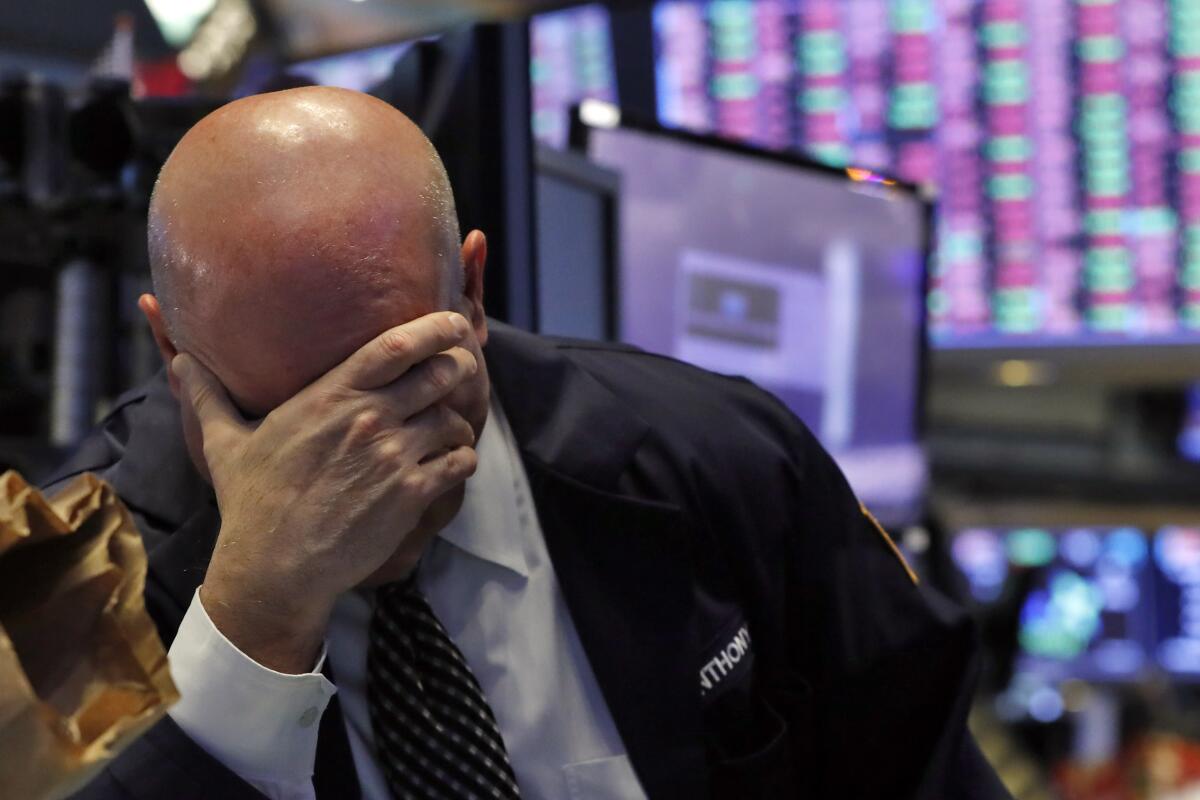The stock market crashed five times before coronavirus. Those disasters can show us how to face this one

- Share via
At 5:12 a.m. on April 18, 1906, the northernmost 296 miles of the San Andreas fault ruptured. The quake lasted 55 seconds, and the eastern side of the fault moved 24 feet. The shaking and ensuing fires — most water mains had been broken by the earthquake — destroyed half of San Francisco, then the largest city west of the Rocky Mountains and, importantly, the financial center of the American West.
The property damage was enormous, but the damage to the economy was even worse. As capital flowed into San Francisco to bankroll the rebuilding, financial markets in the East were left desperately illiquid, at a time when moving capital required actually transporting gold by ship or train. The stage had been set for the first modern American stock market crash, which would take place the following year.
Since that first crash in 1907-08, we have had four others (prior to the one in recent days), in 1929, 1987, 2008 and 2010, and they contain lessons that help put today’s economic crisis in context — and provide guidance for weathering it. In short, this has happened before on a similar scale — and will happen again.
The current crash is normal in many respects, and that’s good news even if it doesn’t seem so in the moment. In 1987, losses from the August top to the October bottom were 36% (it got slightly worse in December). From the top in 2007 to the bottom in March 2009, the loss was more than 50%. As of March 18, the current drawdown was 36%.
All modern American stock market crashes have started with an overinflated stock market — the asset price bubble can’t pop until it’s inflated. The two years ending in 1905 remain the best two-year period for the Dow Jones industrial average in its history. The market crashed in 1907. The two years ending in 1928 were the second-best two-year period ever for the Dow. The market crashed the next year. On Aug. 25, 1987, the Dow was up 43.6% for the year, an astonishing gain. It crashed 55 days later. The Dow was up more than 80% from the end of 2015 to the end of last year, so you might say the stock market in 2020 had it coming, but it was not as overinflated as in previous crashes, and that’s more good news.
This crash is also not unusual in having a purely nonfinancial catalyst. In this case it was COVID-19; in 1907 it was the earthquake, and the 1987 crash was triggered in part by fears of war with Iran.
We have so far avoided one key problem. Crashes often see some new financial contraption break down, leading to wildly turbulent markets, which amplify losses. In 2008 the contraption was mortgage-backed securities, in 1987 it was portfolio insurance, an invention of academics who inexplicably assumed the market would accept steadily increased selling as chaotic markets cascaded lower.
No contraption has yet manifested itself in 2020, and the selling has been orderly, if ugly. The danger from some novel financial contraption remains something that could complicate things, but there’s no obvious suspect. It won’t be your local bank — that money is safe. But Wall Street is overwhelmingly reliant on short-term borrowing to fund even its most basic operations. If lenders balk at making loans because they fear a counterparty’s creditworthiness or because they choose to maintain that liquidity for themselves, our financial system will seize up. This is how investment banks like Lehman Brothers die and how financial chaos is created.
While the crashes are all surprisingly similar, recovery tends to be more idiosyncratic. Fortunately we’ve learned what works and what doesn’t. The impact of the 1929 crash was so profound because the Federal Reserve and the federal government bungled the response. Since 1929 we’ve learned that the Fed should be focused on providing liquidity to the financial system.
The model for that is 1987. The morning after that crash, Alan Greenspan, then chairman of the Fed, issued a terse, 30-word statement which essentially said, “We have a lot of money and we’re going to use it to support the financial system.” That crash didn’t infect the broader economy. In 2008 we had learned these lessons. The federal government launched a raft of programs including the Recovery Act, and bailouts of the auto and banking industries while the Federal Reserve lowered its fed funds rate from more than 5% in 2007 to zero by the end of 2008.
The federal government is already making plans to get cash directly into consumer’s pockets as this crash continues to unfold, and on Sunday the Fed took a page from Greenspan’s shock-and-awe playbook by again slashing its interest rate to zero. People can debate which actions we should be taking and which are likely to be most effective, but these are the steps that have been productive in the past.
It’s important to remember that we have always recovered, and in doing so have found ways to make our financial system more resilient. In response to the panic of 1907, the Federal Reserve was created. After the 1929 crash, the Securities and Exchange Commission was launched; following 1987, we added circuit breakers to slow or stop future crashes. After 2008, with the Volcker rule, we limited the kinds of risks financial institutions can take in their investments. And this time, too, we are likely to find ways to improve safeguards to the economy going forward.
This crash seems more malign than others because the catalyst is an unseeable infectious disease. That means it will bring personal tragedies as well as economic hardships. But stock market crashes always exact a psychic cost. Investors worry about meeting their financial goals. Some stop investing entirely, compounding the damage. The biggest danger will be if newly risk-adverse Americans abandon sensible investment plans that are supposed to pay for educations and retirements.
Scott Nations is the author of “A History of the United States in Five Crashes: Stock Market Meltdowns That Defined A Nation.” He’s also a contributor to CNBC and the founder of a financial engineering firm.
More to Read
A cure for the common opinion
Get thought-provoking perspectives with our weekly newsletter.
You may occasionally receive promotional content from the Los Angeles Times.









